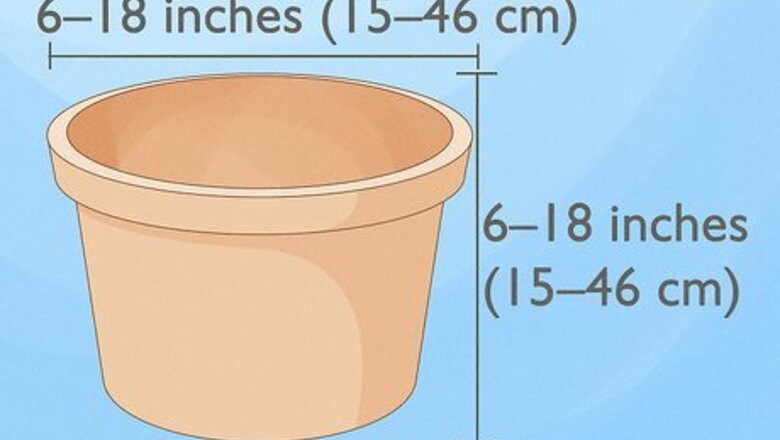
views
Choosing a Suitable Container
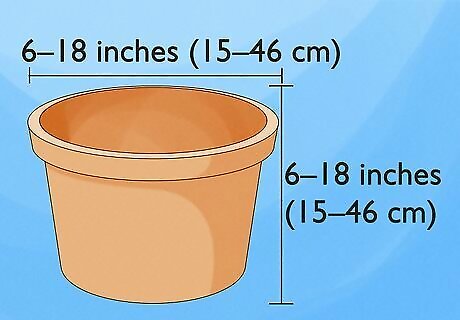
Pick out a spacious container. The container you choose should be big enough to accommodate the type and number of roses you’ll be growing, with a little bit of room left over. Miniature roses that only reach heights of 6–18 inches (15–46 cm) may only require a container that’s 6–8 inches (15–20 cm) deep, whereas larger specimens will need at least 18 inches (46 cm) in order for their roots to spread out comfortably. Box planters, wooden barrels, and washtubs can make great containers for full-sized roses. When it doubt, it’s better to go too big than too small. Roses that are planted in roomy containers grow larger and healthier on average, and also tend to do better over the harsh winter season.
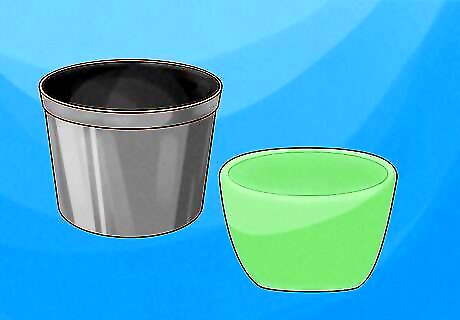
Opt for a lightweight container if you plan on moving your roses around. Containers made from materials like plastic, fiberglass, and recycled composites are easy to pick up and relocate. This feature can be a major advantage if you think you might want to grow or display your roses both indoors and outdoors. Grow bags are also easy to pick up and tote from place to place, and can even be planted in the ground should you decide to make your roses a permanent fixture in your garden.
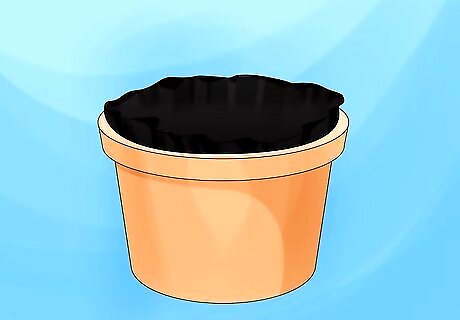
Use a plastic liner with clay pots. Materials like terracotta, ceramic, and concrete heat up quickly when left in the sun. By fitting a heavy stone-type container with a separate plastic liner, you can ensure that your planting soil stays cool and retains vital moisture. Roses that get too hot need more frequent watering, which can be hard on both you and the plant. Most garden supply stores and greenhouses sell plastic pot liners that are designed to fit perfectly inside standard-sized containers. If you don’t want to purchase a separate liner, you can also make your own using a plastic trash bag or several layers of newsprint.
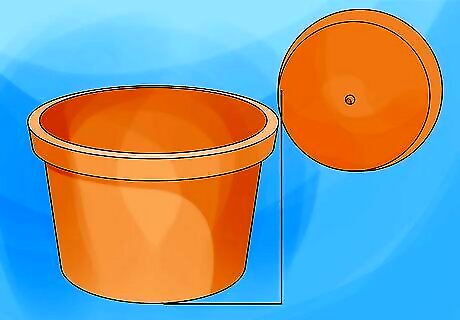
Make sure your container provides adequate drainage. Look for containers that have holes or slits in the bottom. These openings will make it possible for water to flow out of the container once it’s made its way through the soil, reducing the chances of overwatering. If you already have a container you want to use that doesn’t feature built-in drainage holes, you can put a few in yourself using an electric drill. Your roses can develop many undesirable conditions as a result of overwatering, including stunted growth, wilting, and root rot, which can actually kill the plant.
Preparing the Soil
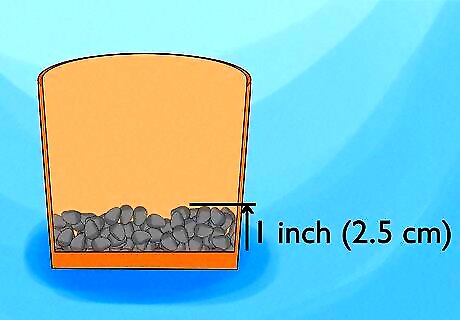
Add a 1 inch (2.5 cm) layer of gravel to the bottom of the container. Pea-sized gravel is ideal, as it holds together well without leaving too much open space, but you could also use a handful of small stones from your garden. A gravel or stone base will help promote proper drainage and prevent the soil at the bottom of the container from becoming too compacted. Sand or clay particles can also be used to give the lower part of the soil a well-drained, loamy texture. It will probably be okay to forego the gravel layer if you’re using a container with good drainage holes and you plan on raising your roses outdoors.
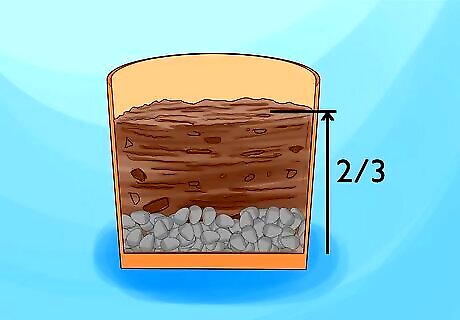
Fill the container ⅔ of the way full with a well-balanced potting soil mix. Just about any standard commercial potting soil will work for growing a small crop of roses, so long as it’s rich in nitrogen and phosphorous. Avoid filling the container all the way to the top—if the soil is too heavy, your roses may have trouble breathing. Look for mixtures that are specifically formulated for use with roses. These soils contain all of the essential nutrients that roses need to thrive. Alternatively, you can try making your own potting soil mixture using one part soil from your yard or garden, one part organic compost, and one part horse, cow, or mushroom manure.
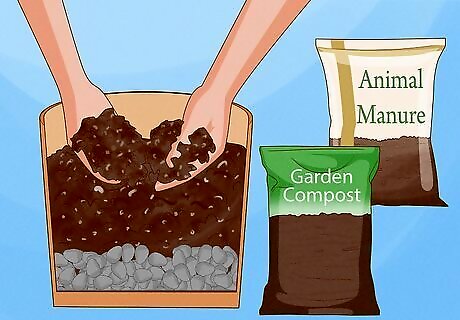
Enrich your soil with a small amount of organic material. Add a handful of garden compost, animal manure, or peat moss to the soil and use a hand trowel to churn the mixture until the organic components have been fully incorporated. Organic amendments will infuse additional nutrients into the planting soil and make it easier for your roses to retain moisture. Some gardening experts recommend adding a small scoop of bone meal or humus to larger rose plants that require extra nourishment. You can also use a slow-release fertilizer meant specifically for roses in your soil. Apply it as needed or as the packaging recommends.
Planting Your Roses
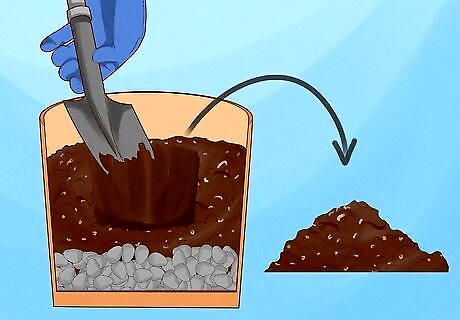
Dig a hole deep enough to seat the rose. Scoop out a narrow depression using the tip of your trowel. Remember that miniature roses should be planted at least 6 inches (15 cm) deep, while full-sized plants and bushes may need 18 inches (46 cm) to get comfortably situated. Heap the loose soil around the edges of the container rather than throwing it out. You’ll need it to fill in the hole later.
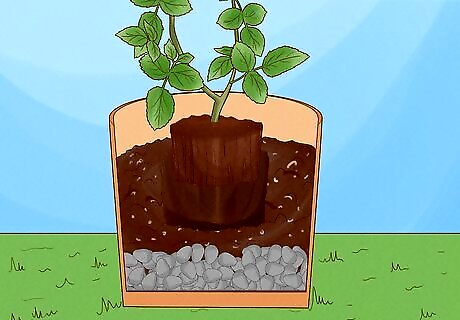
Place the rose inside the hole. Remove the young rose from its nursery pot and transfer it to the growing container. Use your fingers to gently separate the roots so that they’re spread out evenly within the soil. Then, push the loose soil in around the plant and pat it down lightly to compress it. The top of the soil should be about even with the bud onion (the bulbous, woody stalk at the base of the plant from which the stems will sprout), so that the roots are submerged by 1–2 inches (2.5–5.1 cm). Be sure to pack the soil firmly enough to anchor the rose, but not enough to smother or constrict it. Plant your rose at about the same level it was at in the pot or container. You will want a pot that is deep enough to fit your root ball and still leave about 1 inch (2.5 cm) between the soil and the top. This helps prevent spilling when watering.
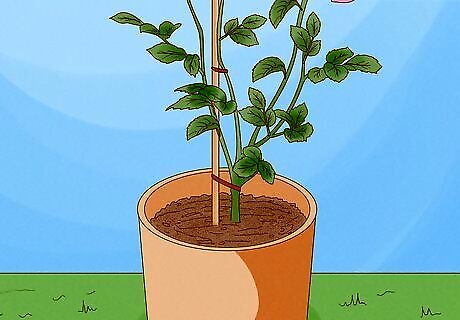
Provide a stake for large roses to climb. If you’re cultivating a full-sized species, drive a gardening stake down into the soil just off to one side of the plant and bind it to the plant's lower canes using a looped rubber band or piece of twine. Once in place, it will act as a support structure for the rose to cling to as it grows. Sink the stake as deep as possible to make sure it's secure. Ideally, it should reach all the way down to the bottom of the container. When raising an entire bush in a barrel, washtub, or grow bag, it’s a good idea to put down multiple stakes 10–12 inches (25–30 cm) apart. If you attempt to grow larger types of roses without the aid of a separate support structure, they’ll eventually droop and spill out over the sides of the container.
Caring for Container Roses
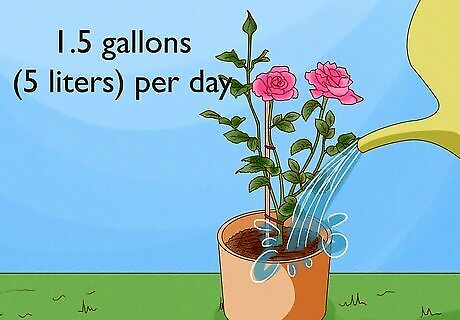
Water your roses regularly to keep the soil moist. Use enough water to thoroughly dampen the soil from top to bottom without oversaturating it. Roses are thirsty plants, and may need as much as 1.5 gallons (around 5 liters) per day. It’s important not to let your roses dry out. In between waterings, stick a finger into the soil. If it feels dry to the touch, it’s probably time to water again. You may need to water your roses more frequently if you live in a particularly warm climate, or they spent most of the day in direct sunlight.
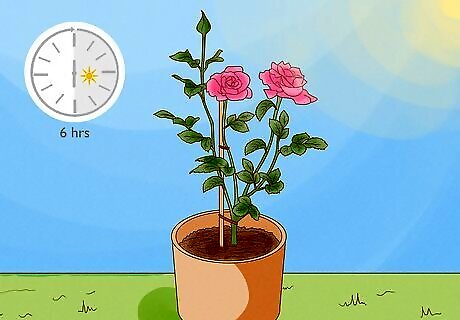
Place your roses where they can get at least 6 hours of direct sunlight a day. Roses flourish in warm, brightly-lit conditions. For this reason, a west- or south-facing window is usually the best place to situate roses grown indoors. They’ll do best when allowed to receive 7 or more hours a day, though miniature roses can get by on 4-5. If necessary, you can reposition your roses throughout the day to keep them bathed in the changing sunlight. Consider letting your roses spend most of the day outside on a sun-drenched porch, patio, or balcony during the warm summer months.
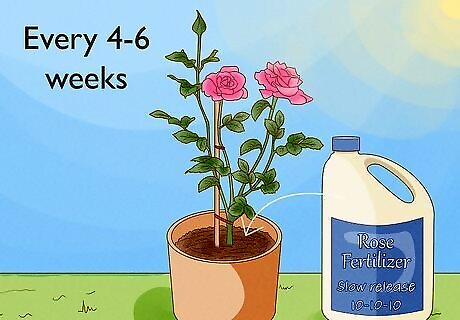
Fertilize growing roses every 4-6 weeks. Go with a well-balanced liquid or slow-release fertilizer formulated for roses, such as 10-10-10 or 12-12-12 formula. These provide rose bushes with most of the nutrients they need to grow. To be on the safe side, always apply fertilizer soon after watering, and only use about half the amount recommended on the product packaging. Overfeeding your roses can burn the delicate roots, especially when they’re dry. Once the flowers begin blooming, you can increase the frequency of your applications to once every 1-2 weeks. Roses grown outdoors will need to be fertilized more often than those grown indoors because of how much faster they develop.
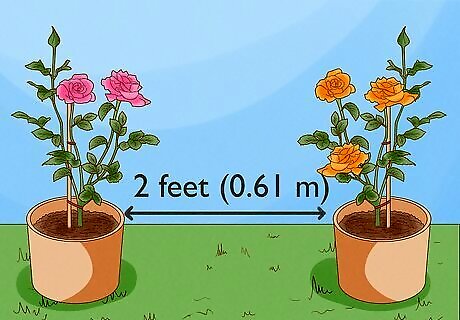
Space your individual containers 2 feet (0.61 m) apart. Leaving a little room between each container will increase the airflow around your roses, allowing them to take in more beneficial gases from the surrounding atmosphere. It can also help prevent the spread of fungal diseases by keeping affected foliage from coming into contact with healthy plants. In addition to preserving the health of your roses, spacing your containers strategically makes it possible to display them over a much wider area.
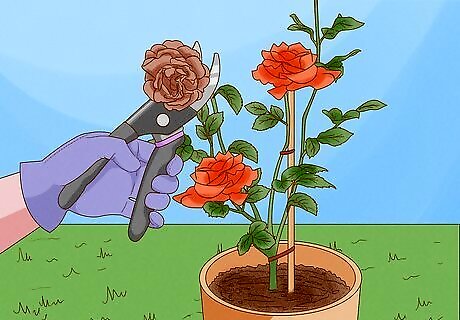
Deadhead dead or dying blooms to make room for new growth. Inspect your roses periodically to look for dead or fading blooms. When you find them, clip the stem down to the first set of five leaflets using a pair of sharp pruning shears. Removing dead blooms will encourage healthy new flowers to return in their place. Get in the habit of pruning your roses back in the spring before they start blooming. Selective pruning can also be used to shape the plant to better fit a particular space. Always prune above an outward-facing bud to prevent inward growth.

Repot your roses every 3 years. When roses outgrow a small container, they can become rootbound, which means there’s no longer enough room for their roots to continue spreading. To prevent an established rose from becoming rootbound, simply loosen the soil around the edges of the old container, lift out the entire plant, and transfer it to its new home. Be sure to fill the new container with fresh potting soil and organic material. It’s especially important to repot roses if you’ve noticed their growth stalling, or they appear sickly despite having their needs met.

















Comments
0 comment